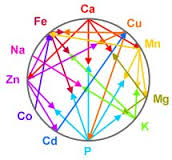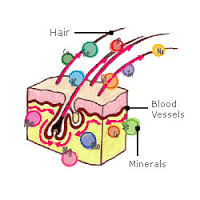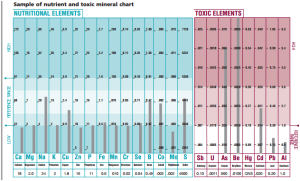What is a Hair Tissue Mineral Analysis (HTMA)?
HTMA is a safe, non-invasive scientific screening tool that uses a sample of hair equal to a tablespoon, taken from the lower back part of the head (occipital region). It is a screening tool that provides beneficial data that can be incorporated into an individual treatment strategy aimed at improving nutritional status and achieving health outcomes.
HTMA can analyse levels of nutritional minerals, toxic minerals and additional minerals also found in the body.
Why test for minerals?
Minerals are considered essential for  human health because they are required for enzymes, muscle contractions, growth, healing, bone structure, teeth, maintaining acid-base balance, water balance and nerve conduction.
human health because they are required for enzymes, muscle contractions, growth, healing, bone structure, teeth, maintaining acid-base balance, water balance and nerve conduction.
Minerals in the body fall into two groups based on the amount found and required by the body – major minerals (Calcium, phosphorus, potassium, sulphur, sodium, chloride, magnesium) and some trace minerals (iron, zinc, copper, manganese, iodine, selenium).
There are also some minerals that can be directly toxic to the human body – lead, mercury, nickel, arsenic, copper, cadmium, antimony and uranium – “Human hair and nails have been found to be meaningful and representative tissues for most of these toxic metals”[1].
The body’s ability to digest and utilise essential minerals is affected by:
- improper eating habits,
- genetic factors,
- medications,
- modern farming techniques,
- depleted soil quality and intake (e.g. 20% decline since the 1970s for selenium in Australia[2] – selenium is an important mineral for enzymes and immune system function),
- nutritional supplements (e.g. excess calcium intake can cause phosphorus and magnesium deficiency),
- environmental toxins[3] and pollution,
- chemical food additives,
- personal hygiene products (e.g. deodorants commonly contain aluminium which displaces zinc in brain tissue, cadmium in welding products displaces zinc throughout the body) and
- stressful lifestyles.
Conditions and symptoms affected by mineral imbalances can include:
| AcneAllergies
Alzheimer’s disease Anaemia Anxiety Arthritis Atherosclerosis Cardiac conditions Dental problems Depression Diabetes Digestive problems Fatigue Hair loss and poor nails Headaches High blood pressure Hormone imbalance Hyperactivity |
Immune impairmentInfertility
Insomnia Learning difficulties Macular degeneration Hypercholesterolemia Hypoglycaemia Memory problems Migraines Mood swings Muscle cramps Osteoporosis PMS Poor wound healing Prostate disorders Skin problems Stress Thyroid disorders |
Why use hair and not blood?
 Hair is made up of mostly keratinised cells that have been fused together. The root of the hair, below the surface of the skin, contains living matrix cells that depend on blood supply for nourishment and growth that allows hair to grow. In the process of growth and division, minerals are keratinised into the growing hair, creating a permanent record of metabolic activity.
Hair is made up of mostly keratinised cells that have been fused together. The root of the hair, below the surface of the skin, contains living matrix cells that depend on blood supply for nourishment and growth that allows hair to grow. In the process of growth and division, minerals are keratinised into the growing hair, creating a permanent record of metabolic activity.
Blood (serum) however gives an indication of current mineral levels transported around the body and cannot accurately measure tissue storage of these minerals. In the body’s attempt to regulate homeostatic balance, maintaining blood levels are deemed more important at the expense of tissue concentrations (for example, ferritin is the storage form of iron, selenomethionine is the predominant storage form in skeletal muscle[4]). Blood levels can often mask both mineral deficiencies and excesses in tissue.
What is the procedure for obtaining a sample of hair?
A sample of hair equal to a tablespoon, is taken from the lower back part of the head (occipital region).
The hair needs to be clean, well-rinsed, untreated and uncoloured. A clean, sharp pair of stainless steel scissors should be used when cutting the hair as near to the scalp as possible without causing injury to the scalp. The cut 4cm closest to the scalp and put on the marked side of the envelope.
In certain situations where head hair is not available then beard or pubic hair may be used, although it is important never to mix different types of hair samples.
Complete directions are provided on the collecting envelope.
Re-testing is not usually required before 6 months (depending on the case).
Sample chart
A comprehensive report is provided by the laboratory that also identifies nutritional ratios and toxic ratios as well recommendations for intervention.
Click here for an HTMA Complete Sample Report.
Citations:
[1] US E.P.A., Toxic Trace Metals in mammalian hair and nails – http://nepis.epa.gov/
[2] http://www.ncbi.nlm.nih.gov/pubmed/16240676
[3] Professor Marc Cohen,MD (RMIT), “The 10 Toxic Truths”, Organic Gardener March/April 2015, pp46-51
[4] http://ods.od.nih.gov/factsheets/Selenium-HealthProfessional/
References and Further reading:
US E.P.A., Toxic Trace Metals in mammalian hair and nails – http://nepis.epa.gov/
http://www.interclinical.com.au/hairtissue.php
Screening of trace elements in hair of the female population with different types of cancers in Wielkopolska region of Poland – http://www.ncbi.nlm.nih.gov/pubmed/25580464
Relationships of hair mineral concentrations with insulin resistance in metabolic syndrome – http://www.ncbi.nlm.nih.gov/pubmed/24671621
Assessment of infantile mineral imbalances in autism spectrum disorders (ASDs) – http://www.ncbi.nlm.nih.gov/pubmed/24284360
Concentrations of chromium, selenium, and copper in the hair of viscerally obese adults are associated with insulin resistance – http://www.ncbi.nlm.nih.gov/pubmed/24643468
Trace elemental distribution in the scalp hair of bipolars using PIXE technique – http://www.ncbi.nlm.nih.gov/pubmed/24548755
Comparing the metal concentration in the hair of cancer patients and healthy people living in the malwa region of punjab, India – http://www.ncbi.nlm.nih.gov/pubmed/24453505
Oxidative stress and status of antioxidant enzymes in children with Kashin-Beck disease – http://www.ncbi.nlm.nih.gov/pubmed/23948978
Cross-sectional relationship between chronic stress and mineral concentrations in hair of elementary school girls – http://www.ncbi.nlm.nih.gov/pubmed/23546894
Hair analysis in health assessment – http://www.ncbi.nlm.nih.gov/pubmed/23415695
Estimation of autistic children by metallomics analysis – http://www.ncbi.nlm.nih.gov/pubmed/23383369
Hair minerals and metabolic health in Belgian elementary school girls – http://www.ncbi.nlm.nih.gov/pubmed/23254772

